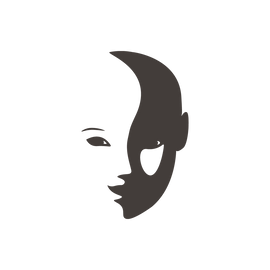I had just completed my apprenticeship as a retail specialist in July 2015. In September 2015, my hairdresser discovered a bald spot on the back of my head.
She asked me if I had cut my hair myself - of course not! When I saw this hairless, round spot on the back of my head in the mirror, I was very worried, especially since weeks before I couldn't shake the feeling that I was losing an unusual amount of hair.
When it all began, September 2015
Of course, from then on I kept a very close eye on the spot that I hadn't seen or felt before my visit to the hairdresser. More small spots appeared. A few months later I went to see my GP to show him the spots that were getting bigger and bigger. He knew straight away that it was alopecia areata and booked me in to see his trusted dermatologist that same day. He told me that he had seen a similar case before and that I would most likely lose all my hair, but that his other patient now had a full head of hair again.

The dermatologist told me straight away that there are various treatment approaches and listed three of them. He let me decide whether and which one I wanted to try. I decided on cortisone injections into the scalp, as I thought that the treatment that sounded the most painful would be the most effective. At the same time, the dermatologist registered me with the IV office. He suggested that I look into the topic of wigs, even though at the time I could still more or less cover my bald spots with my remaining hair.
At the beginning of 2016, I visited a wig shop for the first time and got some advice. I had been losing more and more hair and now wanted to follow my doctor's advice. The wig shop advised me against a hairpiece because the course of the disease is unpredictable and a wig would be the better long-term solution. I still remember my first day at work with a wig. I had been a little unsure of myself for all those months, but now I saw myself with this strange mane and hardly recognized myself in the mirror. It suddenly felt so irrevocable, so definitive and for the first time I was really aware of what my hair had meant to me.
In the summer of 2016, I visited a wig shop for the first time. The first wig, August 2016 That was when I cried for the first time: I felt so uncomfortable, lost and helpless.
Every now and then (especially in the summer) my hair grew back, summer 2017. Everyone at my company knew about it, I didn't want to have to hide. My coworkers and my family supported me tremendously and gave me strength.
The cortisone injections continued for a whole year, but without success. After that, we switched to topical immunotherapy. This therapy showed temporary success for me, which gave me hope. The hair grew back several times, although not everywhere, and then fell out again after a while.
I think that's what has hurt me most about this illness: the unpredictability, the hope that flares up again and again and then the bitter disappointment when it fails again.
I also stopped taking topical immunotherapy and went to see another doctor. I wanted to feel like I had tried everything and not just accepted my fate without fighting.
I spent about three very exhausting years running from doctor to doctor, trying many things that might help and always hoping.
Every setback showed me more and more that it is perfectly fine and perhaps even sensible to accept the illness. At first, that sounds very simple and wise. In fact, it was purely a matter of self-preservation. For several years now, I have been trying to accept the illness (most of the time it works very well) and no longer try out new therapies or miracle cures.
These days I either have a bald head or my own hair (when it grows back sporadically), a fashionable hat and, very rarely, a pretty real hair wig.
I still hope for a full head of hair, just as one can hope for good weather at the weekend. It's not in your hands whether the sun shines or not. But you can have a good plan to have a nice day despite the rain. So I accept my unusual appearance, am grateful that I am otherwise in such good health, and come to terms with the fact that I sometimes attract a few more glances than I would like.
The first great headgear from Kopfrausch in 2018
I recently became a mother and I hope that my beloved daughter has not inherited this disease from me. But if she does, I know that it is possible to cope with the diagnosis of "alopecia areata" and still lead a good life. Maybe I can even be a good example for her.
Alopecia Areata has given me the chance to see myself with different eyes and to like and accept my rough edges a little more. Today I see the disease as an opportunity to grow, to meet people, to try new things, to reassess many things in my life and perhaps it has made me a better person than I was before.









